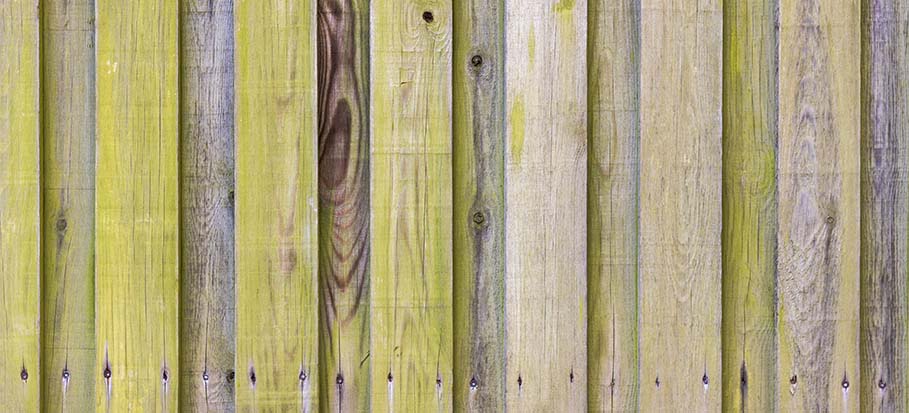
Green algae can make any wooden fence unsightly and uninviting. Add the accelerated deterioration of your fence’s wooden panels and you have quite the problem on your hands. Although algae mostly grow in more shaded areas, deprived of sunlight, it can also thrive in direct sunlight. Therefore your fence isn’t safe even if it gets its fair share of sunshine. Luckily, getting rid of algae off wood is fairly easy. So, you won’t need to invest heaps of money in replacing old fence panels.
- Supplies
- Trusty tools
- Cleaning green algae off wooden fences
- Aditional tips
So if you:
- Are a proud owner of a good old wooden fence;
- Have difficulty cleaning algae off your fence panels;
- Want to know how to clean algae and mildew off wooden surfaces.
Then this post might be just the thing you’re looking for.
Supplies you will need
Before we get into the algae removal process, there are certain supplies you will need to acquire. Make sure you have everything from the following list:
- Bleach
- Wood preserver
- A bucket
- Plastic sheeting
- Rubber gloves
- Work clothes
Most of these are things everyone has lying around their house. However, if there are things you’re missing, you can just stroll down to the closest home improvement store.
Trusty tools
In order to get the best results when removing green algae from your fence panels, you’ll need the following tools:
- A pressure washer
- A garden hose
- A scrub brush
- A paintbrush
If you don’t happen to own a pressure washer and don’t plan on buying one, fear not! There are multiple appliance stores that you can hire one from for a very reasonable price (you’ll usually be charged per day).
Need help with cleaning your wooden fence?
Why not leave it to our professional jet washing speacialists.
- We’re certified:

How to get rid of green algae on fences
Step 1: Cover any surrounding plants
Cover the plants in close proximity of the fence with plastic sheeting. This will protect them from the bleach solution that you’ll be applying to your wooden barrier.
Step 2: Prepare your cleaning solution
Mix two parts warm water and one part household bleach into a bucket. After you’re done, put on your rubber gloves and work clothes.
Step 3: Get down to scrubbing
Take your scrub brush and dip it into the bucket with the cleaning solution. Try to get rid of as much green algae spots off the fence as possible.
Step 4: Wait for around 30 mins
Leave the bleach mixture to sit on the wooden fence for about 20 to 30 mins. When you notice the algae spots fading away, it’s time to act. Rinse the mixture completely, using your garden hose. Don’t ever allow the bleach solution to dry on the wood.
Step 5: Pressure washing time
Set your jet washer on a lower setting (for easily damageable surfaces), between 1500 and 2000 psi. Stand around half a meter away from the fence and begin hosing it down. Without concentrating on one spot for too long, move the sprayer slowly with a sweeping motion.
Step 6: Let the fence dry
Once all the algae and mildew have been cleaned off the fence, let it dry completely.
Step 7: Sand and stain the fence
Sand the fence wherever needed. Then, using a paintbrush, apply the wood preservative to your fence to prevent algae and mildew from growing back. Remove the plastic sheeting from your plants and you’re good to go.
If your fence is old, it’s quite possible some of its original paint will peel off after this cleaning procedure. When that happens, you will need to repaint. Now you have the chance to choose a fence paint which will make your garden look bigger.
Algae is not the only problem we face after heavy rainfalls. Excess moisture also provokes moss growth on wooden and concrete surfaces. If you have difficulties removing moss from concrete, you might want to check our helpful post on the topic.
A few additional tips
- Don’t perform this cleaning method during winter, as the bleach and pressure washer water are very likely to freeze during low temperature.
- Always clean the fence from a distance when using the power washer, as to not damage the wooden surface.
- Instead of a bleach solution, you can also use professional algae and mould remover (for fences).
Takeaways
- Always wear gloves and old work clothes when using bleach to clean your wooden fence (to avoid getting the substance on your skin).
- A pressure washer is a great tool for cleaning algae and mildew from wood, just remember to keep the pressure on low.
- Wood preservatives help prevent algae from growing back on your fence for a longer period of time and are an ideal finishing touch.
- If you are considering changing your wooden fence, we recommend checking our dedicated post on the best types of garden fencing.
***
Did you enjoy this post? If so, why not go and subscribe to our home improvement newsletter for more, interesting and helpful topics.
Image source: Shutterstock / Jannik Bruun